|
The
proposed Bluebird™ hydrogen cartridge
refuelling system is the way forward for
EVs where the current state of the art is far from being clear in
investment terms.
For
this reason we are building in additional flexibility, aiming to produce
a system that works alongside existing energy storage systems such as
batteries, for smarter load levelling and grid operations.
This
unique system is considered to be an important link to resolve the
Chicken and Egg Situation, as to the versatility
that EV's
need for a less cluttered transition from a petrol, to an
electric, or hydrogen
inclusive economy. Not forgetting that batteries play a large part
in the overall scenario and are necessary to accelerate the take up of
EVs, and may work side by side to provide sufficient energy storage
volume and flexibility for sustainable zero emission transport.
The uncertainty in the marketplace may be the biggest reason that there
have been no reasonably priced fuel
cell cars in mass production up to now.

PATENT
SYSTEM - A comprehensive series of patents are being prepared in
connection with the above system. In addition to patent protection
designs copyright and trademarks will follow. These protections will
protect collaborative partners as and when venture capital is needed to
move to trials.
CARTRIDGE
SIZE
& CAPACITY In
2014 Bluebird Marine decided that the
Ecostar DC50™ could benefit with a three-fold increase in
storage capacity when changing from lithium batteries to hydrogen fuel
cell storage cartridges. The DC50 project was iced in January 2016,
as there were no takers, but that was before Greta
Thunberg hoisted the climate
change flag a notch or two. As
of April 2020 the European
Commission (EC), via H2020,
is looking to fund vehicle
architecture to accommodated what amounts to hydrogen cartridges.
Eureka. If only that had been in 1991, when the concept was first
proposed by a Sussex inventor. The USA, UK and EC were 30 years behind
the curve on this one, possibly the result of Red
Flag politics. Now we see more green flags flying as the ice caps
are melting. At the moment
(2020) Bluebird
Energy Systems is looking at the
marketplace to see what is available off-the-shelf at it were. Sadly,
there appears to be nothing suitable on the shelves. A lot of R&D is
necessary to reach advanced technology
readiness levels. The
EC is also looking to fund liquid
hydrogen cartridges for long haul trucks. Bluebird Energy is keen to
incorporate pressurized gas and liquid hydrogen systems in the Universal
cartridge format. These cartridges would be operable in the system
alongside battery cartridges, using SMARTNET
as the supplier to vehicle operators irrespective of their choice of
energy storage. Also incorporating Pay
As You Drive, to make buying or leasing EVs more economical.. HYDRIDES The full cycle
economics of using hydride pellets like those in the Cella system, could
be the subject of a study, if development partners and funding can be
found. The
obvious issues relate to the inclusion of a fuel cell stack inside the
cartridge, or simply using the cartridge for holding hydrogen, whether
in hydride pellet form, or compressed gas cylinders. At the moment, a
hybrid version, incorporating batteries in the power chain for load-leveling
during acceleration, might offer a more practical and economic solution
- also allowing for regenerative braking, which advantage, a pure
hydrogen fuel cell EV loses.
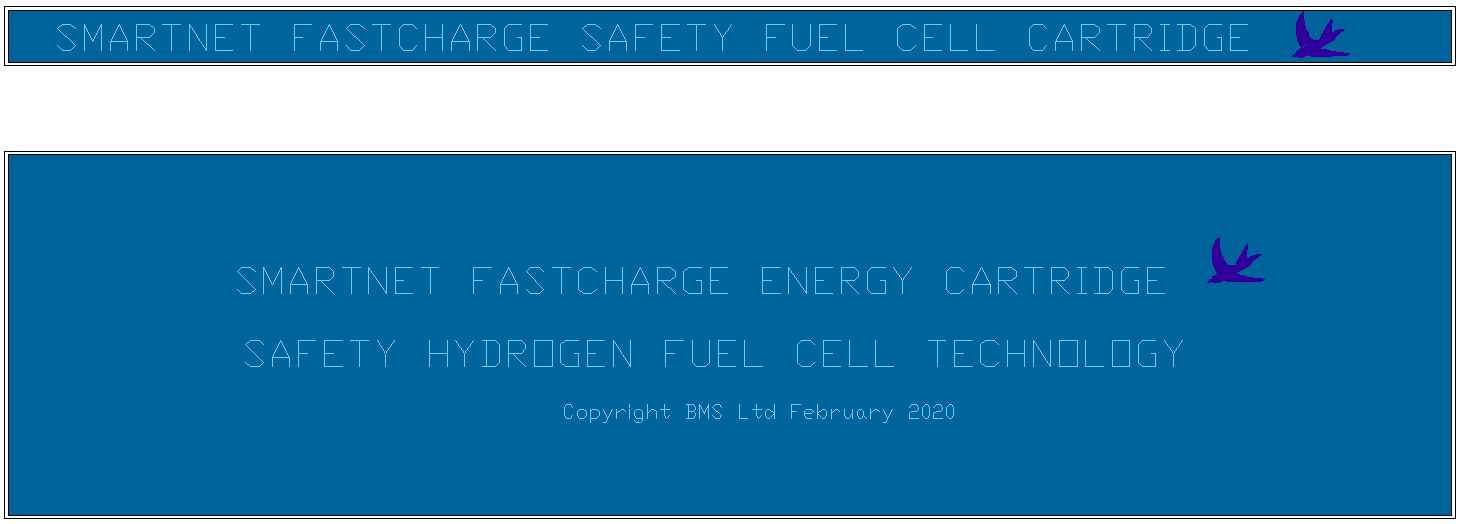
HYDROGEN
FUEL CELL CARTRIDGES - It looks like a battery cartridge. It
performs like a battery cartridge. It stores energy like a lithium
battery cartridge, but it is a hydrogen fuel store and fuel cell
cartridge combination. Where lithium and cobalt raw materials may limit
the production numbers of EVs as green motoring becomes the norm,
hydrogen in a safe format might offer unlimited possibilities to resolve
range
anxiety. The concept is compatible with SMARTNET
FASTCHARGE service stations. NOTE: This is just a concept, not a
product yet. More development is needed before mass production could
be entertained. Design Copyright and patent(s) pending February 2020,
all rights reserved Bluebird Energy Systems.
TELEGRAPH
27 MAY 2013 - FUELLING THE DREAM OF CLEAN CARS In less than five years, your new car could be powered by a high-pressure tank of hydrogen rather than petrol.
This is what the big carmakers are driving at as they seek to produce vehicles with low or no carbon emissions, but they face a number of obstacles in making it a reality.
The first is public acceptance; visions of the blazing Hindenburg airship inevitably spring to mind when hydrogen is mentioned – not really what people want from a family car. Beyond that are the practicalities, how do you fill your car up safely with a volatile gas? How do
petrol stations become high-pressure hydrogen stations?
Cella Energy, an Oxford-based energy technology company spun out of the
government backed Science and Technology Facilities Council and University College London in 2010, aims to answer these questions by supplying hydrogen for fuel in the form of small plastic-looking pellets. They release hydrogen when heated above 100C (212F), which is taken up by a fuel cell to power the car.
“To a man, car manufacturers think hydrogen is the future for vehicles,” said Professor Stephen Bennington, Cella’s co-founder and chief scientific officer. “They’re aiming to roll out the first affordable vehicles from 2015 using high-pressure gas tanks in the back of your car.
However, the infrastructure costs of putting in gas compressors, which cost between $1m (£650,000) and $2m each, mean the average mom-and-pop filling station would have to find $10m. So we’re working on small pellets which act like a fluid, and can be pumped into your car in a familiar way using pumps that are not dissimilar to those used now.”
Cella is working towards having its hydrogen fuel pellets ready for use between 2015 and 2017, as an alternative to high-pressure tanks. The ideal testing ground would be a fleet of vehicles that all get refuelled in the same place, such as Royal Mail vans, said Prof Bennington, 48.
If it succeeds, and the company says it is in talks with all the major carmakers, the scale of the opportunity is clearly immense. But until that happens, Cella has the more prosaic problem of making enough money to keep its research going.
“What we have is a convenient way of storing hydrogen,” said Prof Bennington. “You can use it in lots of places but none of those markets exist yet. The challenge is to make a business around the idea. The car manufacturers’ development cycle is seven years. As a small, venture-capital funded company, we don’t have seven years. We have to find nearer-term revenue.”
Cella is trying to raise between $10m and $15m, which it estimates will fund its research and product development for the next three years. “We’re two years away from serious revenue,” said Prof Bennington. “It’s valley-of-death time.”
Cella’s technology has already won the approval of Space Florida, a state-funded body that awarded the company £2m in 2011 under an agreement in which it carries out research at NASA’s Kennedy Space Centre in Florida as well as in Oxford.
It also raised £300,000 in 2010 from Thomas Swan, a County Durham-based chemicals maker. The company’s early fundraising efforts were helped by winning
Shell’s Springboard award for low-carbon business ideas. “It gave us publicity we could never have afforded, and credibility,” said Prof Bennington.
In March, Cella raised a further $4m from a consortium of high net-worth investors from the north of England, including its chairman Bryan Sanderson, a former chief executive of
BP’s chemicals business.
These fundraising efforts have given Cella the money to set up two labs, one in Florida where it has five employees, and one near Oxford where it has 15 staff. The company also has 15 clean-energy PhD students, mainly from UCL and Oxford, and aims to have 50 staff in three years time.
To start producing revenue, Cella is developing partnerships in a number of industries, starting with long-life batteries. The first market it has identified is unmanned aerial vehicles (the smaller ones used for reconnaissance rather than the armed version).
By putting a fuel cell using its hydrogen pellets into a UAV, it will have three times the amount of energy as with a standard lithium battery, according to Cella. “They’re moving into the civilian market as an eye in the sky, for the police and companies who want to survey their pipelines and rigs,” said Prof Bennington. Cella aims to start making revenue from the replacement batteries within two years.
The second project, which could start producing revenue in three years, is “co-combustion” systems to be used in the diesel engines of heavy-goods vehicles. Cella is working on a cartridge of its hydrogen pellets which would feed into a
diesel engine, making it more effective and reducing carbon emissions by 10pc. The aim is that the cartridge system could be fitted onto older vehicles.
“EU targets are on an escalator and people are fitting catalysts to clean up exhausts,” said Prof Bennington. “It’s neater and potentially cheaper to fix it within the engine itself.” Cella is also working on radiation shielding technology with
NASA, which could extend the life of electrical equipment on satellites from seven to 10 years.
But Prof Bennington does not see this work as a major revenue stream: “It’s exciting to be involved in space but so far we haven’t found anyone to say they will buy it from us now or in 10 years time.”
For the professor, a physicist by trade, the precarious nature and commercial realities of running a start-up have not been the rude awakening some might imagine.
“Academics are now seriously pushed to think about the potential use of any research,” he said.
“In every grant application you write, you have to think, who is going to buy this? Twenty years ago you would have been sneered at for doing something 'applied’ but now you get huge recognition for it. So the selling process has been surprisingly familiar.” 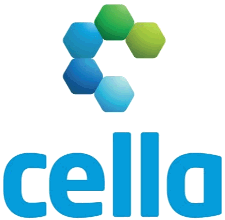
NEW
TECHNOLOGY STORAGE MEDIUM - PERFORMANCE
According to their advertising, one gram of Cella material produces up to 1 litre of
hydrogen gas.
This gives the method a high specific energy, making it ideal for
mobile applications where weight is crucial, provided that the logistics
of replenishment can be solved economically.
The
cellular material can be packaged into a cartridge and combined with a fuel cell,
to offer three times the specific energy of a lithium-ion battery. You
could look at it that the system is comparable to 700 atmosphere compressed hydrogen but without the
safety concerns or cost of infrastructure. But then there is a
transport, collection and delivery issue to take into the equation. 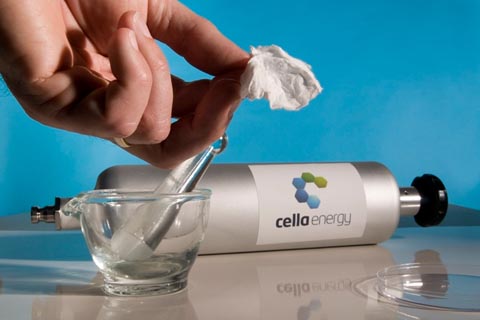
This
is the nano-fiber material that the whole system is based on. Apparently
the fibers are 30 times thinner than a human hair. They may be rolled
into pellets, which can then be transferred using ordinary vacuum pumps.
RECYCLING USED MATERIALS
Cella’s material is based on a chemical hydride so requires a chemical process to recycle it back to
a storage state.
The use of Cella material’s in pellet form can be pumped like a fluid
using inexpensive pumps, like those used in a vacuum cleaner. Such a
system could move the material into and out of a vehicle into and out of
a tanker, for transport to a the recycling plant.
POTENTIAL NET REDUCTION OF CO2
Although they give no figures to support a CO2 reduction, Cella says
that when energy comes from green sources then their material could have a powerful impact on global
CO2 emissions and the security of a nation’s energy supply. That
though, is true of any other energy harnessing method from nature - and
solar assisted charging stations might charge batteries at the point of
recharge, if for example, using the Bluebird™ cartridge recharging
system. We
can though see the potential advantages if there is a logistics solution.
The main advantages are: >
Does not need high pressure
> Does not need cryogenic temperatures
> Has high specific energy (energy per unit weight)
> Has stability at room temperature
> Can be shaped into any spare volume in a vehicle
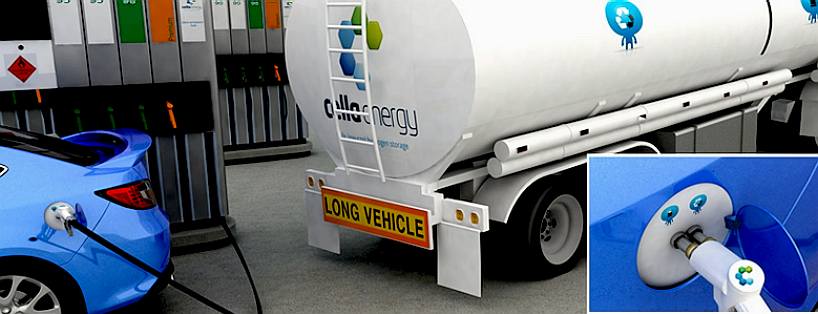
Cella
Energy propose using tankers to distribute their hydride pellets,
presumably taking backloads of spent fuel for re-processing off site.
Would it not make more sense to process the fuel pellets on site? Please
note that Cella ceased trading and has been wound up.
CELLA CONTACTS
Cella Acquisition Ltd trading as Cella Energy
R71 Rutherford Appleton Laboratory
Oxford, OX11 0QX, UK
Telephone: +44 (0)1235 56 7502
Fax: +44 (0)1235 56 7512
Email: info@cellaenergy.com
Company Number: 09019506
USA
Cella Energy US Inc.
Space Life Sciences Laboratory,
Kennedy Space Center,
505 Odyssey Way,
Exploration Park,
Florida 32953, USA
Call: (+1) 321-261-3671 or (+1) 321-261-3674



FUEL CELL WORKS, JANUARY 2011
UK-based Cella Energy has developed a synthetic fuel that could lead to US$1.50 per gallon gasoline. It is hydrogen based fuel and produces no carbon emissions when burned. The technology is based on complex hydrides, and has been developed over a four year top secret program at the prestigious Rutherford Appleton Laboratory near Oxford. Early indications are that the fuel can be used in existing internal combustion engined vehicles without engine modification. Cella can manufacture the materials in the form of micron-sized beads it is possible to move the beads like a fluid. It looks a practical way to introduce hydrogen fuels that is mostly compatible with existing engines and fuel service station infrastructure.
Liquid hydrogen has a specific energy density of about 143MJ/Kg (megajoules per kilogram) compared to regular jet-fuel or kerosene at about 43MJ/Kg. This has big potential for rockets and airplanes and for military applications. Liquid hydrogen is very cold, and has to be stored at -253°C(-423°F). This means keep rockets on launch pads on standby is technically difficult and expensive. Cella’s hydrogen micro-beads are also a liquid hydrogen fuel but can be stored at normal temperatures. This means rockets can be kept on permanent stand-by at significantly reduced cost. So the beads would not be used in the rockets since they 6% hydrogen but for safer and cheaper storage.
Cella Energy uses the benefits of nano-structuring to encase hydrides using coaxial electrospinning. Cella Energy replaces the high pressure cylinders with a conventional shaped fuel tank that can be more easily packaged within an existing vehicle chassis design. Refuelling takes place form a regular fuel pump and requires no high pressure or very-low temperatures. This fits easily within the existing refueling infrastructure and means hydrogen could be provided for a billion existing road vehicles immediately.
Cella Energy have developed a method using a low-cost process called coaxial electrospinning or electrospraying that can trap a complex chemical hydride inside a nano-porous polymer that speeds up the kinetics of hydrogen desorption, reduces the temperature at which the desorption occurs and filters out many if not all of the damaging chemicals. It also protects the hydrides from oxygen and water, making it possible to handle it in air.
The coaxial electrospinning process that Cella uses is simple and industrially scalable, it can be used to create micron scale micro-fibres or micro-beads nano-porous polymers filled with the chemical hydride. Cella believes that this technology can produce an inexpensive, compound material that be handled safely in air, operates at low pressures and temperatures and has sufficiently high hydrogen concentration and rapid desorption kinetics to be useful for transport applications.
Our current composite material uses ammonia borane NH3BH3 as the hydride and polystyrene as the polymer nano-scaffold. Ammonia borane in its normal state releases 12wt% of hydrogen at temperatures between 110°C and 150°C, but with very slow kinetics. In our materials the accessible hydrogen content is reduced to 6wt% but the temperature of operation is reduced so that it starts releasing hydrogen below 80°C and the kinetics are an order of magnitude faster. Although ideal for our proof-of-concept work and potentially useful for the initial demonstrator projects it is not currently a viable commercial material: it is expensive to make and cannot be easily re-hydrided or chemically recycled.
Cella is now working on other hydride materials, these have slightly lower hydrogen contents but it is possible to cycle them into the hydride phase many hundreds of times and we are encapsulating these in hydrogen permeable high-temperature polymers based on polyimide. 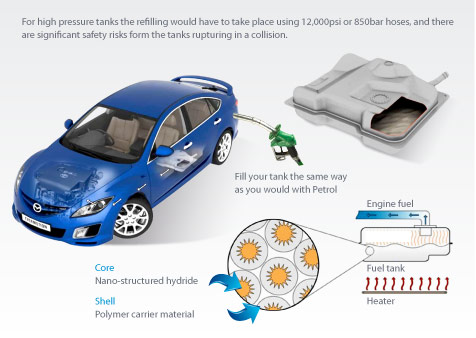
There are two ways to use these materials:
1.
Pure hydrogen solution for Zero carbon emissions or as a fuel additive. 2.
The pure hydrogen solution is a way of storing and delivering hydrogen safely for use in an
internal combustion engine or a fuel cell. 1.
FUEL ADDITIVE
For use as a fuel additive to reduce the carbon emissions from a hydrocarbon fuel such as gasoline, diesel, JP-8, jet-fuel or kerosene.
2. PURE HYDROGEN SOLUTION
Cella say they can manufacture the materials in the form of micron-sized beads it is possible to move the beads like a fluid. This opens up a number of opportunities:
It is no longer necessary to try and rehydrogenate the material within the vehicle. For most hydrogen storage materials this releases megajoules of energy. If the refuelling is to be done in a few minutes, this requires cooling to remove several hundred kilowatts of power. To facilitate rehydrogenation in the 3-4 minutes that the DOE targets stipulate, the thermodynamics require high temperatures and pressures of around 100bar. This requires substantial engineering and as such
Cella don’t believe that on-car rehydrogenation is reasonable. With a fluidized hydride, it is possible to quickly fill or remove the material from the vehicle so that it can be recycled or rehydrided elsewhere. 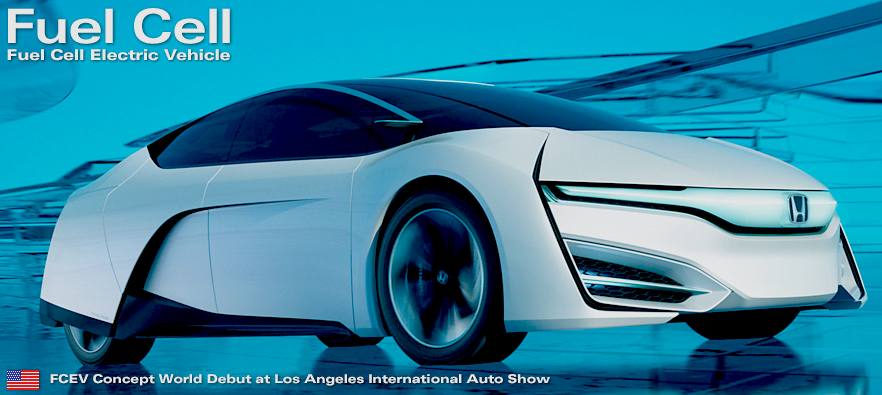
25
June 2012 - Germany is spending more than 40 million Euros to build a network of filling stations for hydrogen and fuel cell cars. The network is to be completed by 2015, when hydrogen and fuel cell cars are expected to be widely available.
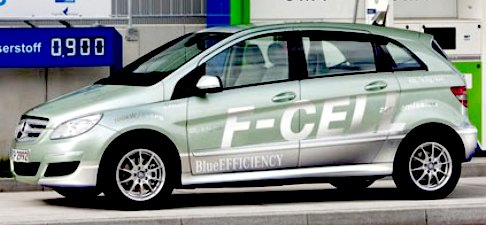
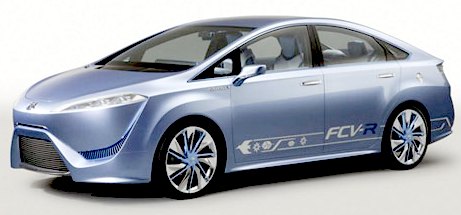
Mercedes-Benz already offers a zero-emission fuel cell B-Class compact, called the F-Cell,
that is already available for leasing in Germany and in California. The Honda FCX Clarity fuel cell sedan also is available for leasing in
California. The FCX Clarity won the Green Car of the Year Award in 2009.
ZERO EMISSION VEHICLES
Most of the large vehicle companies have stated that the long term future of motoring is going to be hydrogen. Many are releasing their first generation of cars in the next few years. For example Toyota unveiled its hydrogen fuel cell car at the
Tokyo Motor show in November 2013. It is aiming to have it on sale by 2015.
All these vehicles will use hydrogen compressed to 700 atmospheres. Cella’s long term vision is supplanting this technology with something that is safer, cheaper and performs significantly better.
Hydrogen fuel cell vehicles are emissions-free at the point of use, and unlike battery electric vehicles where range is limited, have the performance that consumers are familiar with from gasoline or diesel cars. By forming the Cella’s material into small (millimetre) sized pellets the material behaves like a fluid. An inexpensive vacuum pump, similar to that used in a vacuum cleaner, can be used to refuel a vehicle within minutes in a way that is entirely familiar to consumers.
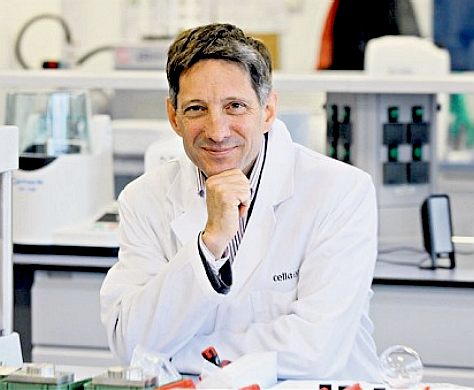
Professor Stephen Bennington,
Managing Director: Cella Energy
BOARD OF DIRECTORS
Jay Lifton, Chairman of the Board
Jay Lifton is the Chief Executive Officer, Co-Founder and Managing Partner of Persephone Capital Partners. Mr. Lifton has over 25 years of corporate finance, capital markets, private equity/distressed investing and corporate restructuring experience. Most recently, Mr. Lifton was co-head of J.P. Morgan’s Investor Driven Capital Markets. His previous position was as Managing Director in J.P. Morgan’s Fixed Income Credit Trading Group.
st. Mr. Lifton received a B.A. in Economics from S.U.N.Y. at Stony Brook, and an M.B.A. from Baruch College.
Alex Sorokin, Chief Executive Officer
Mr. Sorokin is a Co-Founder and General Partner of Persephone Capital Partners. A 25-year veteran of Zolfo Cooper, Mr. Sorokin is a highly-regarded expert in interim management, corporate restructuring and operational advisory services to companies in a wide range of industries. Mr. Sorokin recently acted as Interim CEO of Ener1, a lithium battery manufacturer.
Mr. Sorokin received a B.A. from the Johns Hopkins University.
Stephen Bennington, Managing Director
Stephen is Managing Director at Cella. Stephen is in charge of the corporate strategy and development.
Previously, Stephen was head of a world-class scientific team from the STFC’s Rutherford Appleton Laboratory and the London Centre for Nanotechnology at UCL.
Stephen graduated from Birmingham University in the UK, where he was awarded a PhD in Physics for studying the quantum mechanics of hydrogen in metals.
CELLA'S
PARTNERS
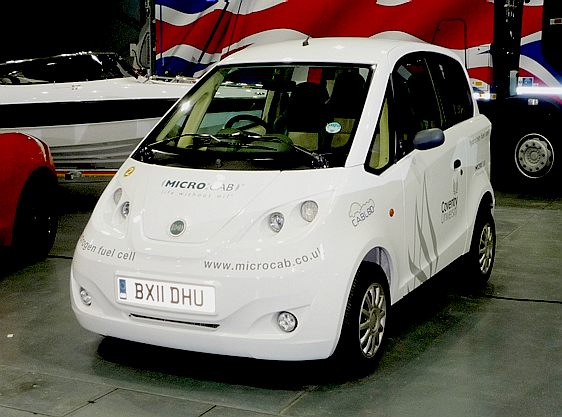
MICRO
CAB - Coventry University's hydrogen powered taxi concept

FUEL
CELL STORE
Fuel Cell Store
features some of the newest products and technologies from renowned international
vendors in educational, science, or leisure applications. Founded in Boulder, Colorado in 1999, Fuel Cell Store is a pioneer of and the longest operating retail site of the fuel cell industry.
They offer a diverse and expansive fuel cell and renewable energy product line on the web, including products catering to educational, research and testing, and industrial applications.
FCS
CONTACTS
Fuel Cell Store
1902 Pinon Drive, Suite B
College Station, Texas 77845
Monday - Friday: 8:00am to 5:00pm (GMT: -6 Hours)
USA Telephone:
+1 (855) 251-0016
International Telephone: +1 (979) 703-1925
|
Horizon
Fuel Cell Properties
|
|
Number
of Cells
|
120
|
|
Rated
Power
|
5000W
(5kW)
|
|
Rated
Performance
|
72V
@ 70A
|
|
Hydrogen
Supply Valve Voltage
|
12V
|
|
Purging
Valve Voltage
|
12V
|
|
Blower
Voltage
|
24V
|
|
Reactants
|
Hydrogen
and Air
|
|
Ambient
Temperature
|
5
- 30C (41 - 86F)
|
|
Max
Stack Temperature
|
65
C (149 F)
|
|
Hydrogen
Pressure
|
0.45
- 0.55 Bar
|
|
Humidification
|
Self-humidified
|
|
Cooling
|
Air
(integrated cooling fan)
|
|
Controller
Weight
|
2500g
(± 100g)
|
|
Stack
Weight (with Fan & Casing)
|
30kg
± 200g
|
|
Hydrogen
Flow Rate at Max Output
|
65
L/min
|
|
Stack
Size
|
350
x 212 x 650mm (13.8" x 8.3" x 25.6")
|
|
Hydrogen
Purity Requirement
|
≥
99.995% (dry H2)
|
|
Start
up time
|
≤
30s (ambient temperature)
|
|
Efficiency
of System
|
40%
at 72V
|
|
Low
Voltage Protection
|
60V
|
|
Over
Current Protection
|
90A
|
|
Over
Temperature Protection
|
65
C
|
|
External
Power Supply
|
24V
(±1V), 8A-12A
|
|
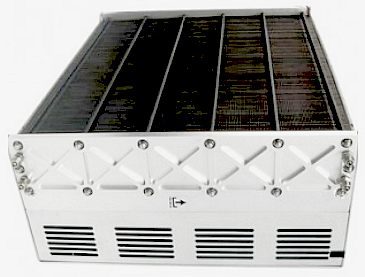
A
5kW PEM stack from Horizon, is available from the Fuel Cell Store via
the internet. It operates at 72 volts and weighs 32.5kg all in at a
retail cost of £22,000 dollars. Such a system cannot begin to compete
cost wise with lithium batteries. An EV would need at least 10kW, and
that is with batteries to cope with acceleration demands. A 20kW/hr
lithium battery cartridge would cost in the region of $15-20,000,
including controllers and mechanics.

FUEL
CELLS - FCH
JTI PROGRAMME 2014
The Fuel Cells and Hydrogen (FCH) JTI is focused on securing long-term clean energy supplies for Europe in addition to the reduction of
greenhouse gas emission from the energy and transport sectors.
A fuel cell is basically an electric chemical converter of fuel directly into electricity and heat, rather than traditional combustion. The fuel we are using is hydrogen,
it is a very environmentally friendly gas. We try to improve the technology in both making hydrogen and converting hydrogen into
cheaper, greener electricity – more efficiently.
According
to the US Dept. of Energy, fuel cells will cost $30-$50
per kw-hr of output by 2017, depending on production volume. To put
this number in perspective, Tesla battery packs are estimated to cost
over $200 per kw-hr of output today and may fall to $140-175
per kw-hr by 2017. In all likelihood, fuel cell vehicles will cost
less than battery electric vehicles by the end of the decade (barring
some major decrease in battery costs, of course).
The
estimated cost of building a hydrogen filling station is $3-5 million
dollars, according to a report
from the National Renewable Energy
Laboratory. While that's definitely a
lot of money, a standard gasoline filling station costs about $2 million
to construct (according to the same NREL report). This report does not
look at, or include information of the proposed Devonshire
Project. Pity!
Battery electric vehicles have a low operating cost, and they
plug in to an existing (and generally efficient) energy grid. However,
most BEVs at this time can't be refueled in 3 minutes, and (as of now) can't go 300+ miles between refueling. BEVs aren't really feasible for use in pickup trucks and SUVs, at least not without serious compromises in tow and payload capacities and/or driving
range. Fuel cell vehicles, on the other hand, have long range, fast refueling, and could easily be used in trucks or SUVs without sacrificing payload or tow capacity.
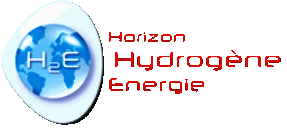
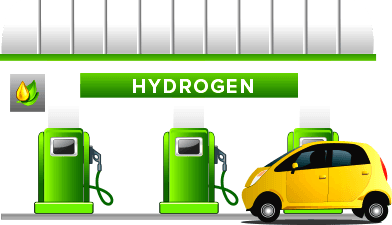
OBSTINATE
EU POLICIES - THEY CAN'T SEE THE WOOD FOR THE TREES
The industry still faces one major challenge in the creation of new hydrogen-based energy products – the absence of a developed marketplace.
One of the biggest challenges to overcome in that there is no market for
fuel cells
or hydrogen. It’s the chicken and the egg
problem. There is no hydrogen, because there are no applications, because there is no fuel cell car, because there is no hydrogen.
An
obvious solution to this chicken and egg situation is to make cars with
a universal cartridge, such as the Bluebird™ system. These cartridges
may contain fuel cells and storage tanks, rather than batteries. Thus, a
car that is initially purchased with a battery cartridge, may change to a fuel
cell cartridge at the flick of a switch. Problem solved. What is all the
fuss about - why doesn't Europe just give BMS a contract to deliver a
working prototype.
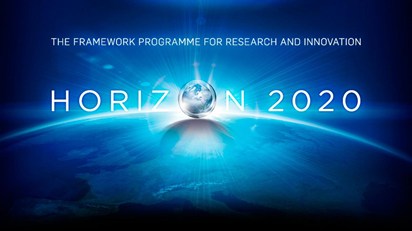
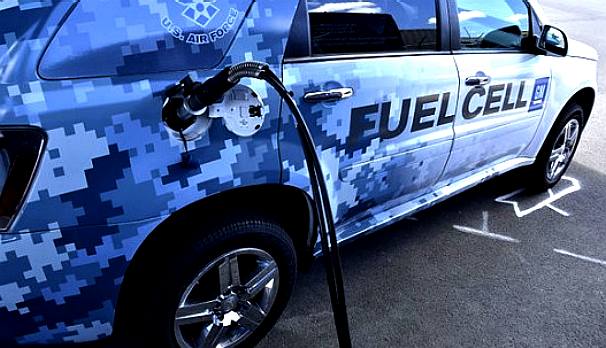
The EU is
trying to encourage research for a sustainable zero carbon future, but
small companies who own the technology such as BMS, do not qualify for
funding under the present system - hence, there is a development log jam
in Europe. See the Devonshire
project for an example of how such a system might work.
HORIZON
2020 - TRANSPORT RESEARCH & INNOVATION - FCH2 - A WASTE OF MONEY
The JTI
was re-launched at the start of 2014 with extra funding and a focus on developing “clean, efficient and affordable
fuel cells and hydrogen technologies”.
It is important to invest in energy storage technology. The problem is not the availability of the energy, it’s the
storage.”
The
real problem is getting finance to the companies that own the
intellectual property rights - or - encouraging institutions and large
companies to license such technology, rather than stagnate out in the
cold. The EU would
rather line the pockets of institutions engaged in research, rather than
employ a company that might produce a practical hydrogen car in just 12
months. This is intellectual and financial procrastination for which
government funding is legendary.
ECOSTAR
DC50 LINKS A-Z INDEX
EXTERNAL
LINKS & REFERENCE
Cella
Energy
cellaenergy
our materials
http://www.horizonhydrogeneenergie.com/
http://www.fch-ju.eu/news/new-website-programme-horizon-hydrog%C3%A8ne-energie-h2e
http://www.fch-ju.eu/
The
Telegraph
finance business club fuelling the dream of clean hydrogen cars
Parts
for Toyota fuel cell myths
Fuel
Cells Works 2011 Cella hydrogen based synthetic fuel with no carbon
emissions
EV
World news Cella
Energy
http://www.nrel.gov/
http://evworld.com/news.cfm?newsid=30338
http://fuelcellsworks.com/news/2011/01/27/cella-hydrogen-based-synthetic-fuel-with-no-carbon-emissions/
http://www.productivgroup.com/
http://www.stfc.ac.uk/
http://welychem.com/
http://www.pnnl.gov/
http://www.microcab.co.uk/
http://www.vtol-technologies.com/
http://www.ox.ac.uk/
http://www.mira.co.uk/
http://l2aerospace.com/
http://www.unipart.co.uk/
http://www.hydrogenlondon.org/
http://www.bartlett.ucl.ac.uk/energy
http://www.thomas-swan.co.uk/
http://www.spaceflorida.gov/
http://cellaenergy.com
http://cellaenergy.com/our-materials/
https://parts.olathetoyota.com/fuel-cell-myths.html
http://www.telegraph.co.uk/finance/businessclub/10082671/Fuelling-the-dream-of-clean-cars.html
http://ec.europa.eu/programmes/horizon2020/en/
|




















